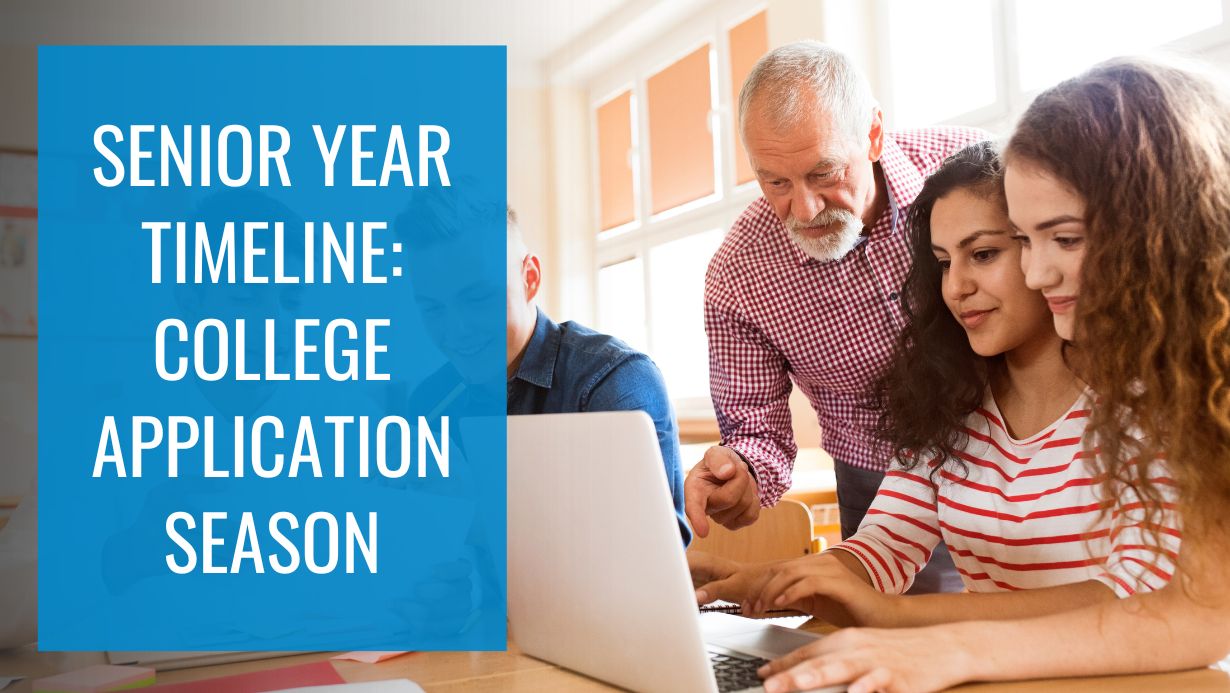For high school seniors, the fall is synonymous with college application season – and rightfully so, most Early Decision and Early Action deadlines fall between October 1 and December 1 each year. While much of the flurry of activity occurs in the fall, the summer before senior year is the perfect time to work on the various components of an application. In my thirteenth year now of coaching students and their families through the college application process, I’ve found it’s best to approach college applications with a strategic timeline. Students who are able to adhere to the timeline find that they are able to pace themselves well and admit to feeling less stress throughout the process than students who wait until the last minute on their applications. Not only that, but students who strategically utilize their time are able to better showcase who they are – as they create thoughtful, intentional responses to each of the components of their applications. Wondering what this timeline looks like? Let me break down the tried-and-true approach that I recommend for my seniors – beginning with senior summer.

May/June
As junior year wraps up and summer begins, now is the perfect time to start thinking about the biggest piece of your Common Application: the personal statement. Even if your college list is still being developed, if you know you are applying to college – getting started on your personal statement is one of the best things you can begin with. Thankfully, the Common Application has already released this year’s essay prompts. I will be writing an entire blog post on the Common Application personal statement itself and how to approach its writing – I strongly encourage checking it out as you begin to brainstorm ideas. In terms of timeline, I would plan to have your Common App personal statement complete by mid-July.
Additionally, this time of year is a great time to start working on both your resume and honors/activities list. Not all colleges offer the ability to upload a resume, but for those that do – it can give you the chance to expand upon the work you have done – a comfort to some students, who find the honors/activities section of the Common App to be somewhat limiting. For the honors/activities list – this is not something that you will directly upload as a document, but rather, eventually fill into the 5 honor slots available to you within your Common Application, and the 10 activities slots. It is recommended that you work on these in a separate document, before adding to the Common Application so you can strategically think through the ordering of activities, the naming conventions, and the very limited – 150-character count descriptions you have to properly convey the impact you have had within said activity. You can later copy and paste your finished product directly into your application, after the Common Application goes live for the next application cycle (typically, the application goes live for the next admissions cycle, on August 1st).
If you still need to complete standardized testing, there are several dates for both the SAT and ACT between now and the first deadlines (in October/November) – so it’s also important to stay mindful of your testing plan, and schedule any necessary remaining testing in advance.
July
By July, you should have an understanding of what your scores look like for all (or most all) of your exams – ACT, SAT, and/or AP exams (though some students may still want to continue to test throughout summer/early fall). Additionally, by this point of the year, you should also have a copy of your transcript – the same version that the colleges will be seeing (with courses and grades listed from 9th through 11th grade, typically). Doing an honest assessment of your scores, alongside your grades, and pairing that academic profile as an applicant with the intellectual and extracurricular endeavors you have pursued, will help give you a better idea of which colleges are reach schools for you vs. target schools vs. likely schools. July is a great time to round out your college list. Most students apply to 8-10 schools on average.
August-September
The 2024–2025 Common Application launches on August 1, 2024. If you were to create an account and log into the Common Application prior to this date, you would see the 2023-2024 application. I encourage all students to create their login with a professional email address that they plan to check regularly throughout the school year. A school-issued email from high school works great but is not necessary. Just make sure that this is an email address that you will check regularly – as most all communication between colleges and universities and the Common Application itself, with you, will happen via this email account.
Once you have a Common Application account, you can start to add colleges and universities to your “My Colleges” tab via the College Search option. Once schools are added to your list, you’ll start to see information for each school populate in your account. This will allow you to see their contact information, their application deadlines, and soon – if not already – if and what each college or university will require from you in the form of a supplement. Some schools will ask just a handful of questions of you as a supplement, others will ask questions and ask essay(s). Supplement essays can range from 50-word short answer responses to 650-word detailed responses. Knowing that every college and university will approach these differently – some asking for 5 or more 200+ word essays, for example – it’s important to make sure that the rest of your application is complete before August, so you can devote the next few months to working on supplement essays – they are just as important as the rest of your file, and should be approached with the same kind of thoughtful intention that you have given to your academic career. In terms of timeline, I would approach supplement essays in the order that the applications are due – work on your earliest deadline’s essays first.
As school starts back up, you will want to make sure you touch base with each of your teacher recommenders, as well as your college counselor, to provide them with any updates to your resume, and to thank them again (and gently remind them) for writing your recommendation letters for college. I encourage each of my clients to also make sure their recommenders know their intended major, so they don’t accidentally make false assumptions about a student’s future aspirations. This major should align with a student’s agreed-upon strategic positioning. If you’re interested in learning more about strategic positioning, our team would love to talk with you further – just reach out via our contact page.
October/November
Each year, we see the earliest admissions deadlines for Early Action at a handful of schools in October. Most schools have Early Action (EA), Restrictive Early Action (REA), and Early Decision 1 (ED1) deadlines in November – but there are a handful that have deadlines in October. Notoriously, we’ve seen October deadlines at schools like UNC-Chapel Hill, Georgia Tech, and University of Virginia, to name a few. The majority of schools have their EA, REA, and ED1 deadlines in November.
Once you have your college list inputted into your Common Application – you will be able to see each college/university’s various deadlines (dependent on the round in which you are applying). All students are responsible for submitting their applications in their entirety by the day of the deadline. Each of my students are encouraged to submit 1-2 weeks ahead of deadlines, so for a November 1 deadline, our targeted date for submission on our timeline would be October 15. By applying early, you leave plenty of time for your school to send in your supporting documentation, which is the next step post-submission.
If you are applying to the UC schools – their application, which is a separate application from the Common Application, is due at the end of November. They only have one round of admission, so if you are targeting a UC school – make sure you are aware of this deadline.
Not every student will be offered interviews from the colleges/universities they apply to, as many schools do not offer interviews to their applicants. For those that do offer interviews, they will start extending interview offers in November/December, for any early applications typically. If offered an interview, it’s essential that you say yes – this interview is not optional. Do your best to prepare for this – mock interviews prior with either your Solomon consultant or a trusted advisor/family friend are helpful. Admissions interviewers do take notes during the interview and write a final report that gets added to your admissions file, to be reviewed as part of your admissions file. While it’s unlikely that an interview will change your admissions decision in a significant way, they can help paint a picture of an applicant – thus helping any borderline admission students better understand the review process.
Ongoing – Fall
The fall is an important time in terms of application work, but it’s also an important time to continue to engage with the colleges that interest you. High school visits, where college admissions counselors come to visit your school, and college fairs, where you can interact with various admissions counselors from institutions nationwide, are great ways to stay abreast of what’s going on at the campuses you are interested in attending. It’s also a great place to ask specific questions you might have about a school, and potentially learn about new schools that you might want to add to your list. Students should also plan to engage online with the schools they plan to apply to. Be checking and interacting with the emails they send you and pay attention to special events they are offering for you to connect with them – both in-person and online and attend where possible.
Also in the fall, if you can, visit any schools that you might not yet have been able to formally visit. You will want to request a formal tour (and interview or information session if offered) through the admissions page of a school’s website. If you are unable to physically visit schools, make sure you are doing so virtually – almost all schools offer virtual tours on their websites these days.
Senior year fall semester is a crucial time to focus on maintaining your GPA and continuing your intellectual pursuits with the same sort of passion you exhibited in the summer and prior years. This can feel like a lot, and it is – remember that this is but a season in the grand story that is your life, and you will get through this. You can do it!
December
Many Early Decision 1 and Restrictive Early Action admissions decisions are released in December. Some Early Action decisions are also released in December, but it truly depends on the institution, as to when they will release – some will release in January/February. This can be a nerve-wracking time, but it’s important to stay positive and continue working hard in school and in extracurricular and intellectual pursuits. In the case that you are deferred from a school, in the early round, having strong updates to share with an admissions committee is going to help you in the next round of application review.
If you were admitted to a school in the Early Decision 1 round – congratulations! You are officially done with your applications! Since Early Decision is a binding agreement, you are locked into attending that institution once admitted. As soon as you receive an acceptance from an ED1 school – you must withdraw your remaining applications elsewhere.
January/February
Most Regular Decision (RD) and Early Decision 2 (ED2) deadlines fall in early to mid-January; think: January 1, 2, 3, 4, 5 deadlines. While this may feel like it gives you the holiday break to work on them, it’s important to realize that your school also needs to send your supporting documents once your application is submitted. Pay careful attention to the supporting documents deadlines as well – they are either due the same day or due a short period of time after the initial deadline. If a school wants supporting documents on the same day that your application is due, and your school is closed for the holiday break still – you need to plan ahead of time for this scenario. I advise all of my students to start working on their RD applications, as well as their ED2 application (if applicable), as soon as they have their EA/REA/ED1 application(s) submitted. Ideally, if you can have all of your applications completed and submitted before the holiday break – this ensures your materials arrive ahead of/on schedule, and honestly, gives you a very much-deserved break after such a busy fall season.
For the EA schools that did not release decisions in December, you will start to see them releasing in January/February. ED2 decisions will typically start to release in late February through early March. Much like ED1, if admitted to a school via Early Decision 2, you must withdraw your remaining applications elsewhere.
March/April/May
All remaining admissions decisions will start to arrive in March – all decisions need to be out to students by April 1. Usually, students find that while this is an exciting time, it can also feel quite daunting. Not every decision goes as expected, for one, but for those students who receive multiple offers of admission – having to choose which school to attend, out of many incredible options, can feel at times, impossible. Continuing to engage with your schools is important in aiding this decision – as the better sense you have of the culture and academics, the more confident you will feel in selecting the best fit school for you.
May 1 is officially considered National College Decision Day. This date represents the deadline to submit your acceptance and make a deposit to attend the four-year college or university of your choice.
We Can Help
In over 12 years now of consulting students and their families through the college admissions process, I think it’s safe to say that no one truly expects just how intense the college admissions process can be. I receive countless words of appreciation each year, even just for something as simple as keeping a student on track and how essential that actually ended up being. Of course, there is the strategy piece, as well as the actual work of helping students find their most authentic voice in their writing and how they express themselves through other areas of the application, we work with students through all of this. If you’re at all curious as to how we can work together, we’d love to talk with you. Just send us a note, and someone from our team will reach out to you shortly.

Former Admissions Reader at Rice University,
3500+ Applications Read and Evaluated
As college admissions professional for the last 16 years, Adrienne has experience working on all sides of the proverbial admissions desk. She has read thousands of applications in her role as an admissions reader for highly selective Rice University, she has aided in the development of admissions and financial aid strategies for colleges and universities worldwide as a higher education enrollment consultant, and she has served as the Director of College Counseling in an elite K-12 school - a role that she was recognized for in 2015 when she was selected as The University of Chicago's Outstanding Educator of the Year.



